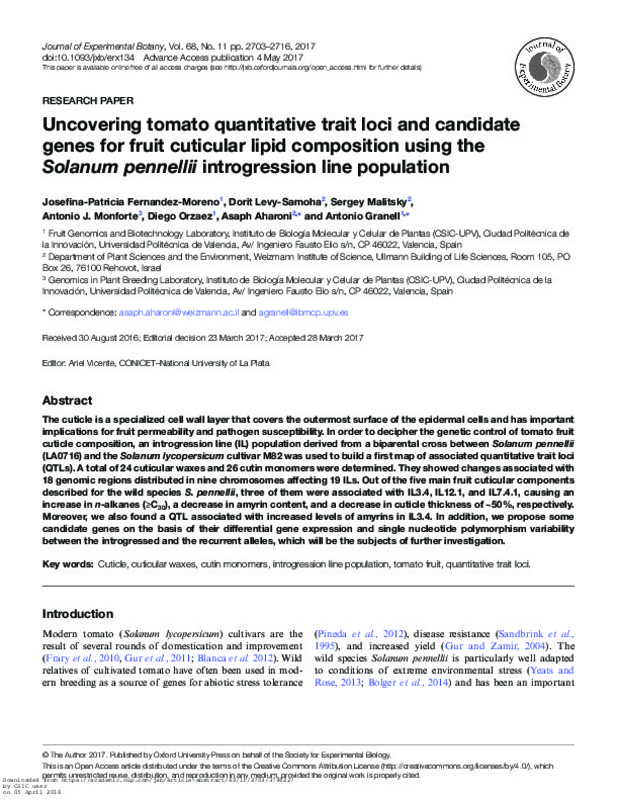JavaScript is disabled for your browser. Some features of this site may not work without it.
Buscar en RiuNet
Listar
Mi cuenta
Estadísticas
Ayuda RiuNet
Admin. UPV
Uncovering tomato quantitative trait loci and candidate genes for fruit cuticular lipid composition using the Solanum pennellii introgression line population
Mostrar el registro sencillo del ítem
Ficheros en el ítem
| dc.contributor.author | Fernández Moreno, Josefina Patricia
|
es_ES |
| dc.contributor.author | Levy-Samoha, Dorit
|
es_ES |
| dc.contributor.author | Malitsky, S.
|
es_ES |
| dc.contributor.author | Monforte Gilabert, Antonio José
|
es_ES |
| dc.contributor.author | Orzáez Calatayud, Diego Vicente
|
es_ES |
| dc.contributor.author | Aharoni, A.
|
es_ES |
| dc.contributor.author | Granell Richart, Antonio
|
es_ES |
| dc.date.accessioned | 2018-09-25T07:42:42Z | |
| dc.date.available | 2018-09-25T07:42:42Z | |
| dc.date.issued | 2017 | es_ES |
| dc.identifier.issn | 0022-0957 | es_ES |
| dc.identifier.uri | http://hdl.handle.net/10251/108090 | |
| dc.description.abstract | [EN] The cuticle is a specialized cell wall layer that covers the outermost surface of the epidermal cells and has important implications for fruit permeability and pathogen susceptibility. In order to decipher the genetic control of tomato fruit cuticle composition, an introgression line (IL) population derived from a biparental cross between Solanum pennellii (LA0716) and the Solanum lycopersicum cultivar M82 was used to build a first map of associated quantitative trait loci (QTLs). A total of 24 cuticular waxes and 26 cutin monomers were determined. They showed changes associated with 18 genomic regions distributed in nine chromosomes affecting 19 ILs. Out of the five main fruit cuticular components described for the wild species S. pennellii, three of them were associated with IL3.4, IL12.1, and IL7.4.1, causing an increase in n-alkanes (>= C-30), a decrease in amyrin content, and a decrease in cuticle thickness of similar to 50%, respectively. Moreover, we also found a QTL associated with increased levels of amyrins in IL3.4. In addition, we propose some candidate genes on the basis of their differential gene expression and single nucleotide polymorphism variability between the introgressed and the recurrent alleles, which will be the subjects of further investigation. | es_ES |
| dc.description.sponsorship | Research at the IBMCP was supported by the Spanish Ministry of Education and Culture (BIO2013-42193-R) and H2020 TRADITOM (634561). AA, AG, and J-PF-M thank COST FA1106 Quality Fruit for STSM and networking activities. This work was supported by the Israel Science Foundation (ISF) personal grant to AA (grant no. 646/11). We would like to thank the Adelis Foundation, the Leona M. and Harry B. Helmsley Charitable Trust, the Jeanne and Joseph Nissim Foundation for Life Sciences, Tom and Sondra Rykoff Family Foundation Research, and the Raymond Burton Plant Genome Research Fund for supporting AA's laboratory activity. AA is the incumbent of the Peter J. Cohn Professorial Chair. We are very grateful to Prof. Dani Zamir for providing us the S. pennellii IL collection and to Prof. Antonio Heredia for his valuable advice in preparing the manuscript for publication. We would like to acknowledge the help offered by the Electron Microscopy Unit at the WIS (Israel) for the TEM sample preparation and imaging, especially Elena Kartvelishvily, Eugenia Klein, and Eyal Shimoni. Finally, we would also like to thank Calanit Raanan and Tamara Berkutzki (Department of Veterinary Resources, WIS) for their help in tissue fixation and embedding, as well as Hanna Levanony (Department of Plant Sciences, WIS) for her help in tissue staining for the light microscopy studies. | es_ES |
| dc.language | Inglés | es_ES |
| dc.publisher | Oxford University Press | es_ES |
| dc.relation.ispartof | Journal of Experimental Botany | es_ES |
| dc.rights | Reconocimiento (by) | es_ES |
| dc.subject | Cuticle | es_ES |
| dc.subject | Cuticular waxes | es_ES |
| dc.subject | Cutin monomers | es_ES |
| dc.subject | Introgression line population | es_ES |
| dc.subject | Tomato fruit, Quantitative trait loci | es_ES |
| dc.subject.classification | BIOQUIMICA Y BIOLOGIA MOLECULAR | es_ES |
| dc.title | Uncovering tomato quantitative trait loci and candidate genes for fruit cuticular lipid composition using the Solanum pennellii introgression line population | es_ES |
| dc.type | Artículo | es_ES |
| dc.identifier.doi | 10.1093/jxb/erx134 | es_ES |
| dc.relation.projectID | info:eu-repo/grantAgreement/MINECO//BIO2013-42193-R/ES/GREEN SWITCHES: DISEÑO DE CIRCUITOS GENETICOS ARTIFICIALES PARA LA PRODUCCION DE PROTEINAS RECOMBINANTES Y EL ENRIQUECIMIENTO NUTRICIONAL DE PLANTAS SOLANACEAS/ | es_ES |
| dc.relation.projectID | info:eu-repo/grantAgreement/EC/H2020/634561/EU/Traditional tomato varieties and cultural practices: a case for agricultural diversification with impact on food security and health of European population/ | es_ES |
| dc.relation.projectID | info:eu-repo/grantAgreement/ISF//646%2F11/ | es_ES |
| dc.rights.accessRights | Abierto | es_ES |
| dc.contributor.affiliation | Universitat Politècnica de València. Instituto Universitario de Conservación y Mejora de la Agrodiversidad Valenciana - Institut Universitari de Conservació i Millora de l'Agrodiversitat Valenciana | es_ES |
| dc.contributor.affiliation | Universitat Politècnica de València. Instituto Universitario Mixto de Biología Molecular y Celular de Plantas - Institut Universitari Mixt de Biologia Molecular i Cel·lular de Plantes | es_ES |
| dc.description.bibliographicCitation | Fernández Moreno, JP.; Levy-Samoha, D.; Malitsky, S.; Monforte Gilabert, AJ.; Orzáez Calatayud, DV.; Aharoni, A.; Granell Richart, A. (2017). Uncovering tomato quantitative trait loci and candidate genes for fruit cuticular lipid composition using the Solanum pennellii introgression line population. Journal of Experimental Botany. 68(11):2703-2716. https://doi.org/10.1093/jxb/erx134 | es_ES |
| dc.description.accrualMethod | S | es_ES |
| dc.relation.publisherversion | http://doi.org/10.1093/jxb/erx134 | es_ES |
| dc.description.upvformatpinicio | 2703 | es_ES |
| dc.description.upvformatpfin | 2716 | es_ES |
| dc.type.version | info:eu-repo/semantics/publishedVersion | es_ES |
| dc.description.volume | 68 | es_ES |
| dc.description.issue | 11 | es_ES |
| dc.identifier.pmid | 28475776 | |
| dc.identifier.pmcid | PMC5853401 | |
| dc.relation.pasarela | S\356433 | es_ES |
| dc.contributor.funder | Ministerio de Economía y Competitividad | es_ES |
| dc.contributor.funder | European Commission | es_ES |
| dc.contributor.funder | Israel Science Foundation |








